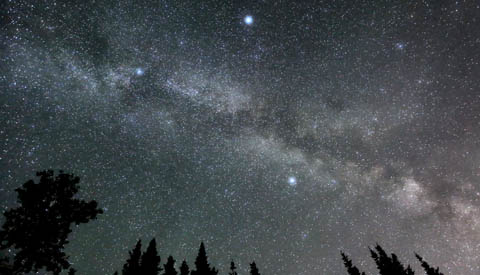There's a beautiful and mind-bending article in Sunday's New York Times about galactic walls. Vast as the Milky Way is and hard as it is for us to comprehend space in such magnitude, it is really just a small bounded enclosure; and like a garden fence, it obscures us from the view of much vaster domains beyond. If we could only peak over or around the Milky Way, we would glimpse all these other galaxies strung out like jewels on an endless necklace. Here's a link to the article in case you haven't read it yet.
The article reminded me of the Chinese legend of the Cowherd and Weaver, which is basically the Chinese version of Pyramus and Thisbe set against the backdrop of the Milky Way. When the Chinese looked skyward on a summer evening, they saw Vega and Altair positioned on either side of the great Milky Way as the celestial embodiment of these star-crossed lovers. Magpie Bridge is how they described the band of darkness that spans the celestial river of light flowing between them. Much as I admire the explanatory powers of modern astronomy, I find the ancient legend equally compelling in providing a way to comprehend the boundlessness of the summer sky at night.
As companion to the NY Times' article, here's my translation of Magpie Bridge, by the Song poet Qin Guan:
Magpie Bridge of the Immortals
A filigree of cloud drifts by chance
A star sends its regrets as it shoots across
The luminous flow of the Milky Way
In the vast skies of autumn
Cowherd and Weaver meet
For their brief rendezvous
Equal to ten thousand trysts
In the earthly domain below
Supple and yielding as water
The fleeting ecstasy of a dream
To stand and mutely gaze across
The span of Magpie Bridge
The route of eternal return
When two hearts unite forever
A day or night together is of no concern
鵲橋仙
纖雲弄巧
飛星傳恨
銀漢迢迢暗渡
金風玉露一相逢
便勝卻人間無數
柔情似水
佳期如夢
忍顧鵲橋歸路
兩情若是久長時
又豈在朝朝暮暮

No comments:
Post a Comment